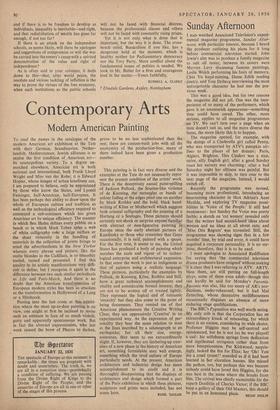Contemporary Arts
Modern American Painting
To read the names in the catalogue of the modern American art exhibition at the Tate with their German, Scandinavian, Nether- landish, Mediterranean, Jewish alliances is to realise the first condition of, American art— its cosmopolitan variety. To a degree un- matched elsewhere, American art is both national and international, both Frank Lloyd Wright and Miss van der Rohe; it is Edward Hopter, whose images of urban loneliness can, I am prepared to believe, only be appreciated by those who know the States, and Lyonel Feininger, half-American, half-European. It has been perhaps this ability to draw upon the whole of European culture and tradition as well as the technological efficiency required to command a sub-continent which has given American art its unique efficiency. The manner in which Ben Shahn defines every pebble on a beach or in which Mark Tobey spins a web of white calligraphy ovir a large surface or the sheer virtuosity in the handling of materials in the collection of prints brings to mind the advertisedents in the New Yorker wherein every phrase and picture, like the svelte blondes in the Cadillacs, is so smoothly tooled, turned and presented. I find this quality in its artistic manifestations very diffi- cult to define, but I recognise it again in the difference between- two such similar periodicals as Life and Paris-Match. And there is no doubt that the American transformation of European modern styles has been as absolute as the transformation in Hollywood of a Lang or a Hitchcock.
Passing into the last room at this exhibi- tion where the most up-to-date painting is on view, one might at first be inclined to revise such an estimate in face of so much violerit, gutty and apparently spontaneous work. But in fact the abstract expressionists, who last week caused the brow of Pharos to darken, prove to be no less sophisticated than the rest; these are custom-built jobs with all the anonymity of the production-line; many of them indeed have been given a production number.
This painting is in fact very diverse and the examples at the Tate do not necessarily repre- sent the present condition of the artists' work. There is the deceptively casual paint-spilling of Jackson Pollock, the Soutine-like violence of de Kooning, the rectangles or bands of colour fading at the edges piled one on another by Mark Rothko and the bold, black hand- writing of Kline or Motherwell which suggests both oriental calligraphy and the painting of a Hartung or a Soulages. These pictures should certainly not shock or surprise anyone familiar with abstract or non-figurative painting in Europe since the early abstract pictures of Kandinsky or those who remember that Goya occasionally, it is said, painted with a spoon. For the first time, it seems to me, the United States has produced a body of painting which matches the scale and vigour of its techno- logical enterprise and architectural expansion. In that sense the work is just as indigenous as that of painters using a realistic language. These pictures, particularly the examples by Pollock, de Kooning, Kline, Rothko and Still, have a great technical accomplishment and vitality and considerable formal interest; they are not to be written off or treated lightly. They represent the logical end of romantic 'sincerity' but they also come to the point of being documents. They remind me of that American phenomenon the Creative Writing Class; they are oppressively 'Creative' in an experimental way. As the expression of per sonality they bear the same relation to man as the lines inscribed by a seismograph to an earthquake; for all their. size, energy, assurance, they seem to me extraordinarily slight. If, however, they are limbering-up exer- cises of a new phase in the history of American art, something formidable may well emerge, something which the tired culture of Europe particularly needs. At the present, American architecture and industrial design has more accomplishment to its credit and it is thoroughly disappointing that the displays of architecture and design which formed a part of the Paris exhibition in which these pictures, sculptures and prints were included, has not


































 Previous page
Previous page